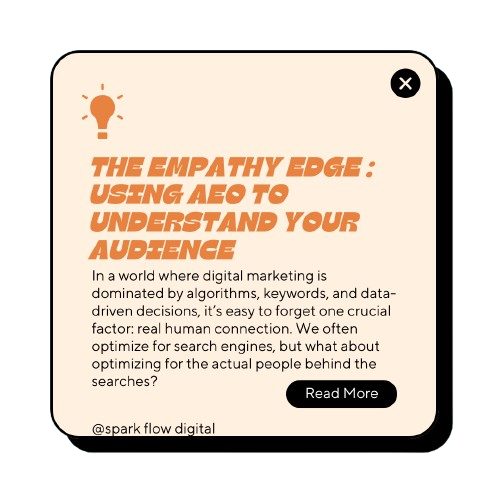Address
304 North Cardinal St.
Dorchester Center, MA 02124
Work Hours
Monday to Friday: 7AM - 7PM
Weekend: 10AM - 5PM
Address
304 North Cardinal St.
Dorchester Center, MA 02124
Work Hours
Monday to Friday: 7AM - 7PM
Weekend: 10AM - 5PM

In a world where digital marketing is dominated by algorithms, keywords, and data-driven decisions, it’s easy to forget one crucial factor: real human connection. We often optimize for search engines, but what about optimizing for the actual people behind the searches? This is where AEO (Automated Experience Optimization) meets empathy, forming a powerful combination that can transform your online presence.
At its core, AEO isn’t just about gaming the system to rank higher—it’s about crafting an experience that genuinely serves your audience. By understanding their needs, emotions, and behaviors, you don’t just climb the SERP (Search Engine Results Page) ladder—you build trust, loyalty, and meaningful engagement. Let’s explore how combining empathy with AEO can be your biggest competitive advantage.
Think about the last time you Googled something in a moment of frustration, curiosity, or urgency. Maybe you were searching for a quick fix to a tech problem, looking for health advice, or trying to find the perfect gift for a loved one. Every search begins with a human need.
Yet, so many websites miss the mark. Instead of helpful, conversational, and intuitive experiences, users often encounter keyword-stuffed content, slow-loading pages, or robotic-sounding answers. The result? They bounce, and your rankings suffer.
Empathy bridges this gap. When you design digital experiences with real human struggles and emotions in mind, your content becomes more engaging, relevant, and trustworthy—exactly what search engines reward.

AEO takes the principles of SEO a step further by prioritizing user experience over pure keyword mechanics. Instead of just helping search engines understand your site, AEO helps your site understand its visitors. Here’s how:
Search engines are getting smarter, and so should we. AEO leverages AI to analyze search intent—whether someone is looking for information, a product, or a quick solution. Instead of generic content, AEO-driven strategies tailor responses based on what the user actually needs in the moment.
Example: If a user searches “best running shoes for beginners,” an AEO-optimized site won’t just list products—it might include a helpful buying guide, a video tutorial on picking the right fit, or a chatbot that answers personalized questions.
AEO tools use behavioral data to create tailored experiences. By tracking user interactions, preferences, and past activity, brands can deliver content that resonates on a personal level.
Example: Imagine landing on a website and being greeted with recommendations that match your past searches. Instead of sifting through irrelevant content, you instantly find what you need—making the experience feel intuitive and seamless.
With the rise of voice search and AI chatbots, users are interacting with digital platforms more conversationally. AEO ensures that responses mimic natural, helpful conversations rather than robotic, keyword-heavy answers.
Example: If a user asks, “What’s the best way to remove a coffee stain?” AEO ensures the answer is quick, clear, and engaging—like a helpful friend giving advice, rather than a search engine spitting out a lifeless list of instructions.
Empathy-driven AEO doesn’t just create better user experiences—it directly impacts your search rankings. Here’s how:
🔹 Reduced Bounce Rates: When users find immediate value, they stay longer. Time-on-page and engagement signals tell Google that your content is high-quality.
🔹 Higher Click-Through Rates (CTR): Engaging, well-optimized content ranks higher in search results and attracts more clicks, improving overall visibility.
🔹 Voice Search Domination: Google prioritizes clear, direct, and conversational responses for voice queries—something AEO is built for.
🔹 Increased Conversions: A seamless, empathetic user experience doesn’t just attract traffic—it turns visitors into loyal customers.
The digital landscape is evolving, and businesses that embrace human-centered optimization will lead the way. Instead of treating AEO as just another technical strategy, think of it as a way to connect, empathize, and engage with your audience.
Next time you create content, ask yourself: Would I enjoy this experience if I were the user? If the answer is no, it’s time to optimize—not just for search engines, but for real human beings.
By integrating AEO with genuine empathy, you’re not just climbing the SERP ladder—you’re building something far more valuable: trust.
What’s your biggest challenge when it comes to understanding your audience? Let’s discuss in the comments!